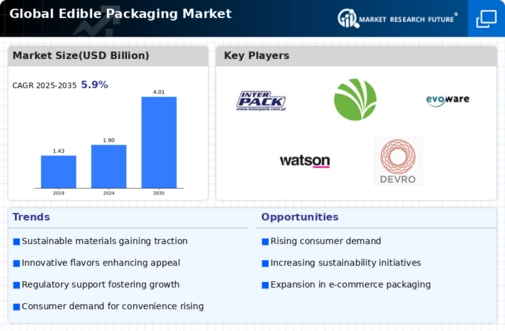Top Industry Leaders in the Edible Packaging Market

Imagine a world where your snack wraps itself along with your sandwich, or your takeout container morphs into a delicious dessert. This eco-friendly dream is becoming a reality thanks to the burgeoning edible packaging market, a landscape buzzing with both promise and intense competition. Let's take a bite out of this fascinating realm, exploring the strategies shaping market share, industry news, and recent developments that are nibbling at the future of packaging.
Strategies Adopted: A Feast for Innovation
-
Innovation Pioneers: Giants like Aptar Pharma and Mondelez International are pushing the boundaries, developing edible films from seaweed, algae, and other plant-based materials. Think dissolvable coffee pods and wafer-thin cookie packaging that doubles as dessert. -
Cost-Conscious Caterers: Players like UFlex and Amcor are focusing on affordability, utilizing readily available materials like rice bran and cassava starch to cater to price-sensitive segments and emerging markets. This ensures their delicious solutions reach a wider audience. -
Niche Chefs: Smaller players are carving out unique niches by specializing in specific applications. Some focus on edible coatings for fruits and vegetables, while others cater to the pharmaceutical sector with dissolvable drug delivery films. This targeted approach allows them to excel in specialized areas.
Factors that Flavor the Market Share Pie:
-
Sustainability Spotlight: Consumer and regulatory pressure is fueling the demand for eco-friendly solutions. Edible packaging eliminates plastic waste, minimizes environmental impact, and aligns with sustainability goals, resonating with environmentally conscious consumers. -
Convenience Cravings: Edible packaging offers on-the-go convenience, eliminating the need for separate containers or utensils. This caters to busy lifestyles and resonates with consumers seeking streamlined solutions. -
Sensory Symphony: The ability to customize taste, texture, and even color unlocks exciting possibilities. Think flavor-infused wrappers or spice-coated containers that enhance the overall food experience. This opens doors for innovative marketing and brand differentiation. -
Technological Twists: Integrating smart features like edible sensors or QR codes adds a layer of interactivity and traceability. This opens up potential for personalized experiences, data collection, and brand engagement.
Key Players:
- WikiCell Designs Inc. (U.S.)
- Nagase & Co. Ltd. (Japan)
- JRF Technology LLC (U.S.)
- Tipa Corp (Israel)
- Interpack (U.S.)
- Pace International LLC (U.S.)
- Ingredion Inc (U.S.)
- Safetraces Inc. (U.S.)
- Dupont de Nemours and Company (U.S.)
- Tate & Lyle Plc. (U.K)
- Coveris Holdings (U.S.)
- MonoSol LLC (U.S.)
- Evoware (Indonesia)
- Watson Inc. (U.S.)
- Devro plc (U.K)
Recent Developments:
August 2022: The leading coatings business Nippon Paint China collaborated with BASF to launch innovative edible packaging that is environmentally friendly and compatible with the Nippon Paint dry-mixed mortar family of products.
August 2023: NatureWorks, a leading biopolymer manufacturer, announced a collaboration with XyloBio, a bioplastic developer, to create innovative edible films and coatings for food packaging
September 2023: The Sustainable Packaging Coalition launched the "Edible Packaging Innovation Initiative" with a $2 million grant from the Walmart Foundation to accelerate research and development in the fiel
October 2023: The European Union (EU) Horizon 2020 program awarded €6 million to the "BIO-BASED PACK" project, which focuses on developing biodegradable and edible packaging solutions for various food products
September 2021: PrimaFresh 60 Organic, a premium brand of edible plant-based coatings, was unveiled by Pace International LLC. By better-controlling dehydration, the company created the solution specifically to improve the fresh attractiveness of the stone fruits.
October 2020: New edible seaweed packaging was introduced by the London-based startup Notpla as a replacement for traditional plastic packaging.
January 2020: A New York-based business called Loliware introduced edible straws made from algae and seaweed. Seaweed is used by Loliware, which then grinds it up and mixes it with water, color, and minerals.









